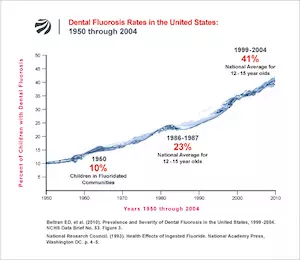Over the past century, the levels of fluoride in foods purchased at the grocery store have steadily increased due to several factors including; the mass fluoridation of water supplies, the introduction of fluoride-based pesticides and the use of mechanical deboning processes in the meat industry.
One of the biggest problems is produce – both organic and non-organically grown — which is sprayed with pesticides. The newer pesticides contain alarmingly high levels fluoride making the typical North American’s daily consumption about 1.8 milligrams of fluoride — almost twice the amount of fluoride delivered from drinking one liter of fluoridated water. The consumption of non-organic foods is now thought to account for as much as one-third of the average person’s fluoride exposure.
WHERE DID WE GO WRONG?

Courtesy www.FluorideAlert.org
Early in 2011, the U.S. Department of Health and Human Services (DHHS) recommended that water fluoridation programs should lower the levels added to water from 1 ppm fluoride 0.7 ppm. Although helpful, even this measure clearly does not go far enough to solve the problem, as many children continue to ingest levels of fluoride much higher than is recommended, or considered ‘safe’. When you consider all of the sources of fluoride contamination it isn’t surprising that we are seeing a dramatic increase in dental fluorosis (a tooth defect caused by excess fluoride intake) and a marked rise in cases reported over the past 60 years.
WHERE IS ALL THIS FLUORIDE COMING FROM?
The fluoride-based pesticide called cryolite (a white or colorless mineral made up of fluoride, sodium and aluminum in crystal form) is essentially sodium aluminum fluoride, which is used for its ability to kill produce-loving insects. Cryolite also adheres to produce in a thick layer that effectively ‘seals’ the produce in pesticide and is extremely difficult to remove before consumption. Fresh produce that is temporarily stored in a warehouse environment is also treated with a gas fumigant, used to kill insects and rodents. This fumigant is recognized to leave extremely high levels of fluoride residue “in or on” stored foods.
The naturally occurring levels of fluoride in fruits, vegetables, meat, grain, eggs, milk and fresh water supplies are generally very low (less than 0.1 ppm) with the exception of seafood, tea and deep-well water which all have elevated fluoride levels without human interference. As a general rule, the fluoride level in food increases as a byproduct of the industrial food-making process. This is particularly true in the U.S. where mass water fluoridation programs are in use, since food processors use the public water supply to make their products. The basic rule is more processing equals the more fluoride. Juice that is not made from concentrate will thus have less fluoride than reconstituted juice.
Organic food is less contaminated than non-organic food and a person’s exposure will thus be reduced if they eat more organic fruits, vegetables, grains, and legumes. Cereals, mechanically deboned meats, and black or green tea are sources to avoid if possible. Mechanically deboned meat is problematic because “most meats that are pulverized into a pulp form (e.g., chicken fingers, chicken nuggets) are made using a mechanical deboning processes. This mechanical deboning process increases the quantity of fluoride-laden bone particles in the meat. As a result, research has found that mechanically deboned meat contains higher levels of fluoride” (The Fluoride Action Network, http://www.fluoridealert.org/content/chicken/), which is then transferred to the consumer’s dinner table. Black and green teas are naturally high in fluoride regardless of whether they are grown organically without pesticides due to how the plant readily absorbs fluoride thorough its root system.
WHAT’S SO BAD ABOUT FLUORIDE?
Recent studies have shown that hydrofluorosilicic acid levels in the body increases lead accumulation in bone, teeth and other calcium dependent tissues. This happens when the free fluoride ion acts as a transport of heavy metals, allowing them to enter into the soft tissues where they normally would not be able to go, including sensitive organs such as the brain.
In terms of acute toxicity (the amount that can cause immediate toxic consequences), fluoride is more toxic than lead but slightly less toxic than arsenic – which explains why fluoride has long been used in rodenticides and pesticides. It is also the reason accidents involving over-ingestion of fluoridated dental products including fluoridated gels, supplements and water can cause serious poisoning even leading up to death. There are reports of people who have in fact developed crippling skeletal fluorosis – a bone disease caused by excessive consumption of fluoride — from drinking high amounts of iced tea alone.
According to the Fluoride Action Network (FAN) excessive fluoride exposure is well known to cause a painful bone disease (skeletal fluorosis), as well as a discoloration of the teeth known as dental fluorosis. It has also been linked to a range of other chronic ailments including;
- arthritis,
- bone fragility,
- glucose intolerance,
- gastrointestinal distress,
- thyroid disease,
- cardiovascular disease
- certain types of cancer
People who are at highest risk to fluoride include infants, individuals with kidney disease, individuals with nutrient deficiencies (particularly calcium and iodine), and individuals with medical conditions that cause excessive thirst.
Fluoride also has the ability to stimulate the harmful effects of other chemicals and heavy metals in the environment, potentially making them even more harmful than they would be otherwise. For example, when you combine chloramines with the hydrofluorosilicic acid, the combination becomes very effective at extracting lead from old plumbing systems, promoting the accumulation of lead in the water supply – water which is then consumed by animals and humans alike.
